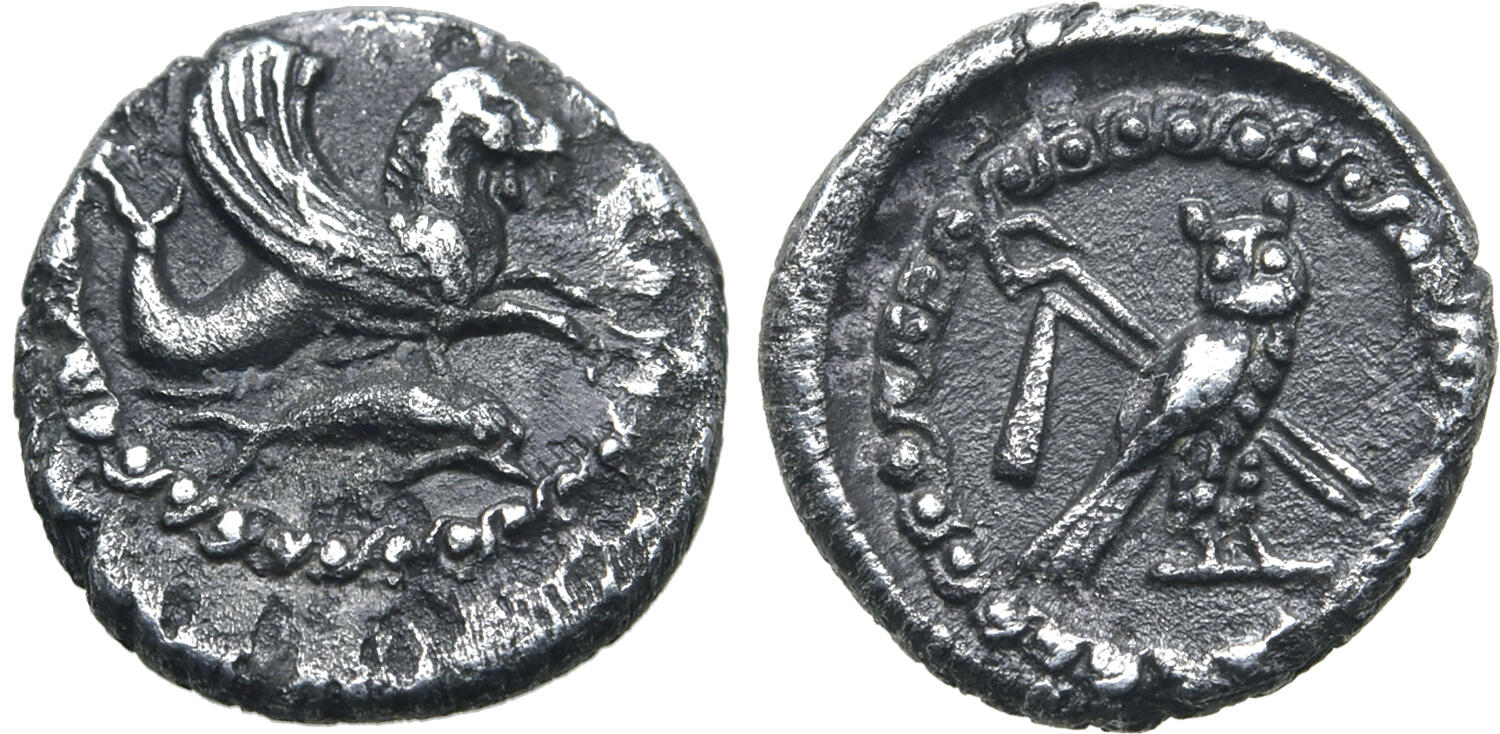Tyre, silver, sixteenth shekels (425-394 BCE)
From SILVER
425 BCE - 394 BCE Silver 1,061 kg
Description
| ObverseInscription or printing placed on the obverse.: | Hippocamp to right, dolphin below |
| ReverseInscription or printing placed on the reverse.: | Owl standing to right, head facing, crook and flail over shoulder |
Mint and issuing power
| MintIdentifies the place of manufacture or issue of a numismatic object.: | Tyre | Ancient regionAncient region.: | Phoenicia | Modern countryModern country: Lebanon | AuthorityIdentifies the issuing power. The authority can be "pretended" when the name or the portrait of X is on the coin but he/she was not the issuing power. It can also be "uncertain" when there is no mention of X on the coin but he/she was the issuing power according to the historical sources: | Persian Empire |
Chronology
| FromIdentifies the initial date in a range assigned in a numismatic context. | 425 BCE | toIdentifies the final date in a range assigned in a numismatic context.. | 394 BCE | PeriodTime period of the numismatic object.: Classical 480-323 BC |
Physical description
| MetalThe physical material (usually metal) from which an object is made.: | Silver |
Median weightMedian of the weights of numismatic objects (in grams). in grams | 0.60 | DenominationTerm indicating the value of a numismatic object. Examples: tetradrachm, chalkous, denarius.: | 16th shekel | StandardStandard.: | Phoenician |
Image

S2055 Tyre 16th shekels 425-394.jpg [1]
References
| Die study referencePublication of the study: | Elayi - Elayi 20091Elayi - Elayi 2009, p. 65-75, n° 430-612 (Series II.1.1.3) | ||
| Coin series referenceReference to coin series study: | Sear II2Sear II, n° 5908, HGC 103HGC 10, n° 331 | ||
| Coin series web referenceCoin series web references: | |||
Obverse dies distribution
| FrequencyFrequency of specimen in distribution. ᵖ | Number of obversesNumber of obverse dies. ᵖ (o) | % (o) | Number of coinsNumber of coins. (n) | % (n) | Die nameName(s) of the die(s). |
| 1 | 22 | 57.89 | 22 | 37.93 | 3, 8, 10, 11, 12, 14, 16, 17, 18, 20, 21, 22, 23, 24, 25, 27, 29, 30, 32, 33, 36, 66 |
| 2 | 12 | 31.58 | 24 | 41.38 | 1, 2, 4, 7, 9, 13, 15, 26, 28, 31, 34, 65 |
| 3 | 4 | 10.53 | 12 | 20.69 | 5, 6, 19, 35 |
| Total | 38 of 38 | 100 | 58 of 58 | 100 |
Reverse dies distribution
no distribution is available
Quantification
| Number of obversesNumber of obverse dies. ᵖ (o) | 38 | Number of singletons (o1)The number of singleton coins. ᵖ | 22 |
| Number of reverse diesNumber of reverse dies. (r) | 48 | Number of coinsNumber of coins. (n) | 58 |
| Coins per obverse dieNumber of coins per obverse die. (n/o) | 1.53 | Coins per reverse dieNumber of coins per reverse die. (n/r) | 1.21 |
| Reverse per obverse ratioRatio of obverse dies divided by reverse dies. (r/o) | 1.26 | Percentage of singletons (o1)number of coins (n) divided by the number of singletons (o1) ᵖ | 57.89 % |
| Original number of dies (O) (Carter 1983 formula)The estimation of the number of coins according to Carter 1983 ᵖ | 88.42 | Coins struck if 20,000 as average productivity per dieCoins made if the average productivity for obverses (according to Carter) is 20,000. ᵖ | 1,768,400 |
| Original number of dies (O) (Esty 2011 formula)The estimation of the number of coins according to the singleton formula in Esty 2011 ᵖ (O) | 110.2 | Survival rate if 20,000 as average productivity per dieSurvival rate if average productivity is 20,000. ᵖ | 0.00003 |
| Coverage (o = % of O) (Esty 1984 formula)Esty 1984 - coverage (% of O) ᵖ (o = % of O) | 62.07% | Die productivity if survival rate 1/2,000Average productivity if survival rate is 1/2,000. ᵖ | 1,311.92 |
| Weight of silver (in kg) if 20,000 coins per die (O = Carter formula)Carter 1983 * Median weight * 20000 (*10 if gold or electrum) ᵖ | 1,061 kg <br /> 1,061 kg | Die productivity if survival rate 1/5,000Average productivity if survival rate is 1/5,000. ᵖ | 3,279.8 |
Remarks
References
- ^ Elayi, Josette - Elayi, Alain G. (2009), The Coinage of the Phoenician City of Tyre in the Persian Period (5th-4th cent. BCE), Orientalia Lovaniensia Analecta 188, Leuven, Peeters, 517 p.
- ^ Sear, David R. (1979), Greek coins and their values. Vol. II, Asia and North Africa, London, xlviii, p. 317-762
- ^ Hoover, Oliver D. (2010), The Handbook of Greek Coinage Series. 10. handbook of coins of the Southern Levant : Phoenicia, southern Koile Syria (including Judaea), and Arabia, Lancaster-London, lxxix, 201 p.